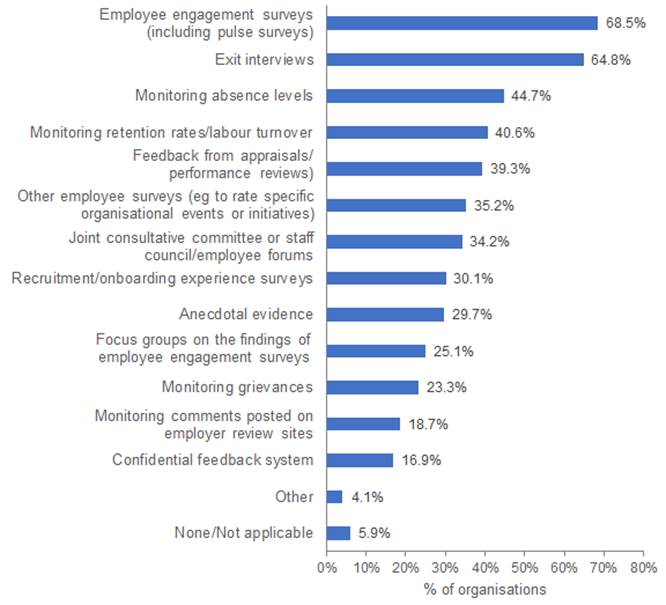Most companies rely heavily on employee surveys
But there are other ways to understand employee engagement.
Why You Should Care
The 'Great Resignation' has highlighted a lack of employee engagement and satisfaction.
Learn how you can make strides to improve employee experience and keep your best talent.
Collecting and understanding employee feedback has never been so important. In a world where teams are often dispersed, and millions have left the workforce, it makes sense to see how employees are doing.
In fact, the practice can lead to increased productivity and avoid the costly process of hiring new staff.
Tom Gibby, the co-founder and CMO of The Bot Platform, summarised the importance of employee engagement in an article for UNLEASH: “One thing is certain, companies need to begin working on effective processes to keep staff engaged and happy today or their business will feel the impact tomorrow.”
Despite businesses recognizing a need for quality engagement, there is no magical solution that will improve the experience of employees.
Fortunately, an online source of legal compliance, good practice and benchmarking information, XpertHR, has spoken to 220 organizations with a total of 460,000 employees to get a greater insight into how they address the needs of employees.
The state of employee engagement
The majority of businesses (69%) said that employee surveys give the most actionable insight into employee engagement or experience.
However, this area is still in need of improvement as only 17% of respondents who used surveys rated them as “very effective” in assessing engagement levels. Instead, surveys seem to have a middling effect with 75% of survey users labeling them as “fairly effective”.
The second most common way to gather actionable insights was exit interviews, with 64.8% of respondents noting that it was a good way to understand problem areas. Of course, the issue with this method is that an employee is already lost by the time insight is presented.
When fighting attrition, businesses need to get ahead of these problems rather than allowing staff to leave before formulating a strategy.
Many companies are facing this challenge and this was reflected in the ‘Great Resignation‘ which has seen employees re-evaluate their relationship with work and exposed skill gaps in organizations across the world.
Employers are recognizing this issue with more than half (52.3%) of respondents, after noticing the factors affecting employee engagement, including remote working, emotional and physical wellbeing, and increased workloads, subsequently made changes to their approach in gathering feedback from employees to improve channels of communication.
Additionally, 67.7% of employers are planning specific initiatives to support employee engagement over the coming year.

Feedback methods that give actionable insight into employee engagement or the employee experience
How to improve employee engagement
Recognizing issues is not enough and improving employee engagement requires a strategy and tools that will help an organization reach its goals.
Noelle Murphy, the senior HR practice editor at XpertHR, gave her thoughts on how organizations can improve the experience of employees: “A truly effective HR strategy is driven by clear, honest and relevant employee feedback – without it, employers are simply guessing what is important to their employees.”
Murphy added: “After a period of turbulence, it’s clear hybrid working is here to stay and it can be a good thing for employee engagement levels, depending on the approach employers take around employees’ sense of purpose and autonomy, and how they manage progression and learning.
“Ensuring people managers have the skills and experience to act effectively as coaches will also help to drive engagement levels, irrespective of where the employees are carrying out their work from one day to another.”
Of course, finding the right tools, to monitor employee feeling as companies juggle hybrid working and dispersed, can be difficult.
Murphy advised: “Putting the most efficient engagement and performance feedback methods in place, such as employee surveys for volume married with a richer, less structured employee feedback process, employers can be certain they have access to a true picture of what is important to employees about their working life.
“Having the best quality data in the world is worthless if there are not tangible and meaningful actions taken by the employer. There is a real opportunity for employers to shift the dial around employee engagement and experience, the pandemic as a crisis has created the space for real change.”
Sathya Smith, CEO and founder of people management platform Piper, told UNLEASH about the need for companies to go beyond the data.
Smith explains: “Any HR department fighting to retain and engage employees needs to look beyond electronic surveys, and instead invest in technology solutions that enable managers to make the one-to-one engagement process as beneficial and effective as possible.”
HR leaders approach how they get employee data differtently, and XpertHR’s research reflects this. However, both Smith and Murphy note the need for managers to sit down and openly listen to employees.
Once managers do this, they can feed back to an organization about how to move forward and put the data they have, no matter how its been collected, to good use.
Sign up to the UNLEASH Newsletter
Get the Editor’s picks of the week delivered straight to your inbox!

Senior Journalist
Dan combines his first-hand experience alongside the latest news and opinions in the HR Technology space.
